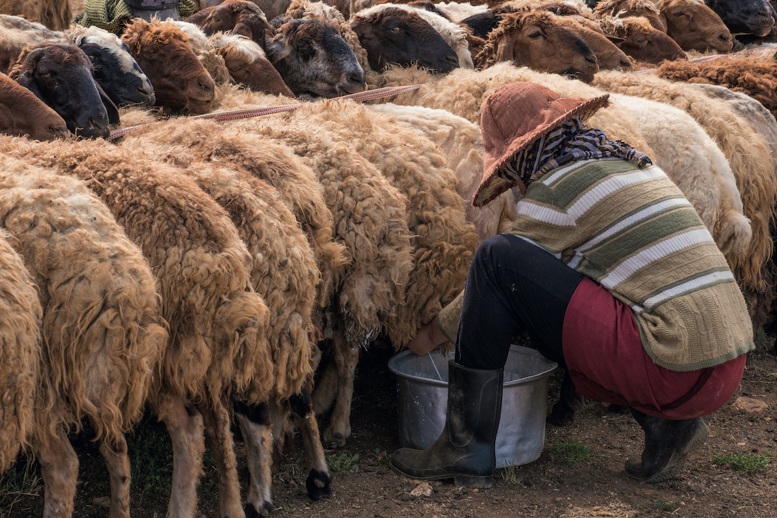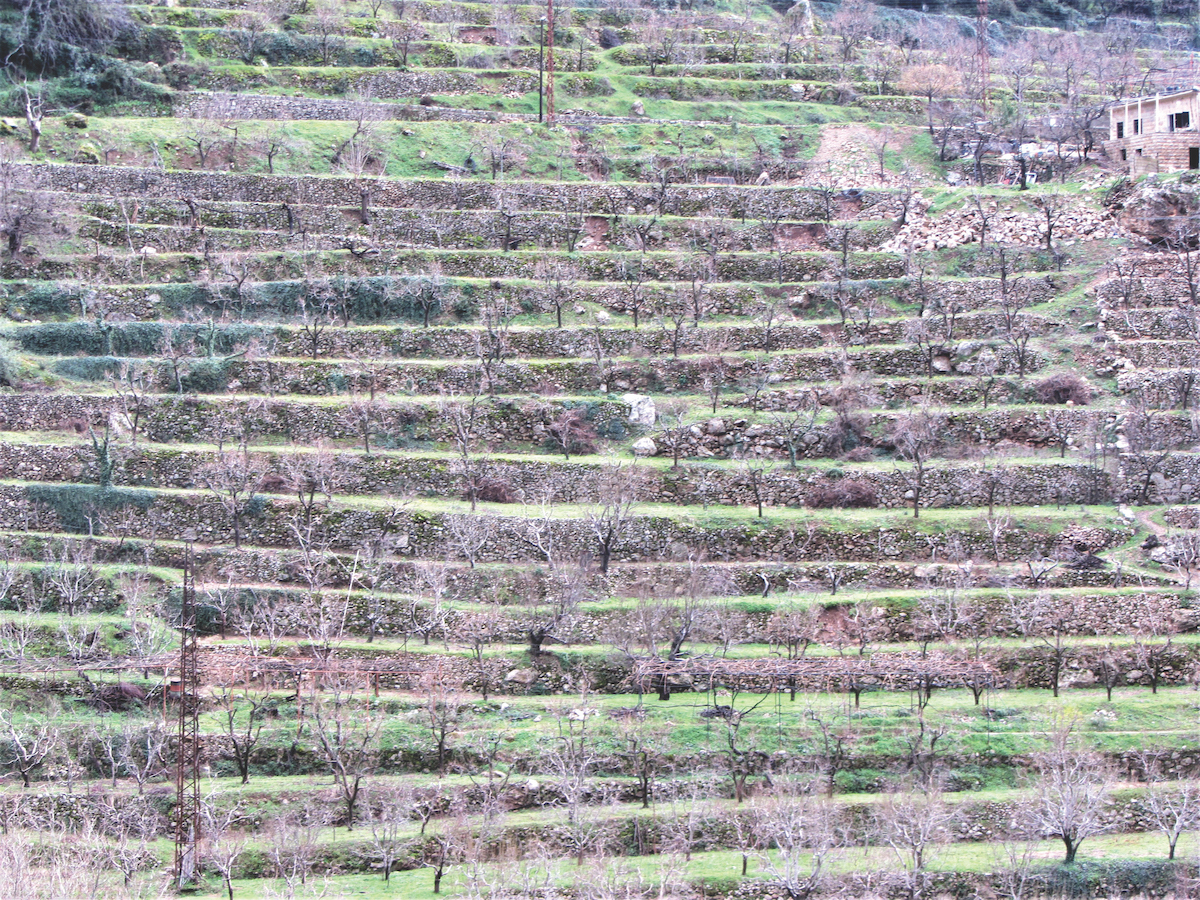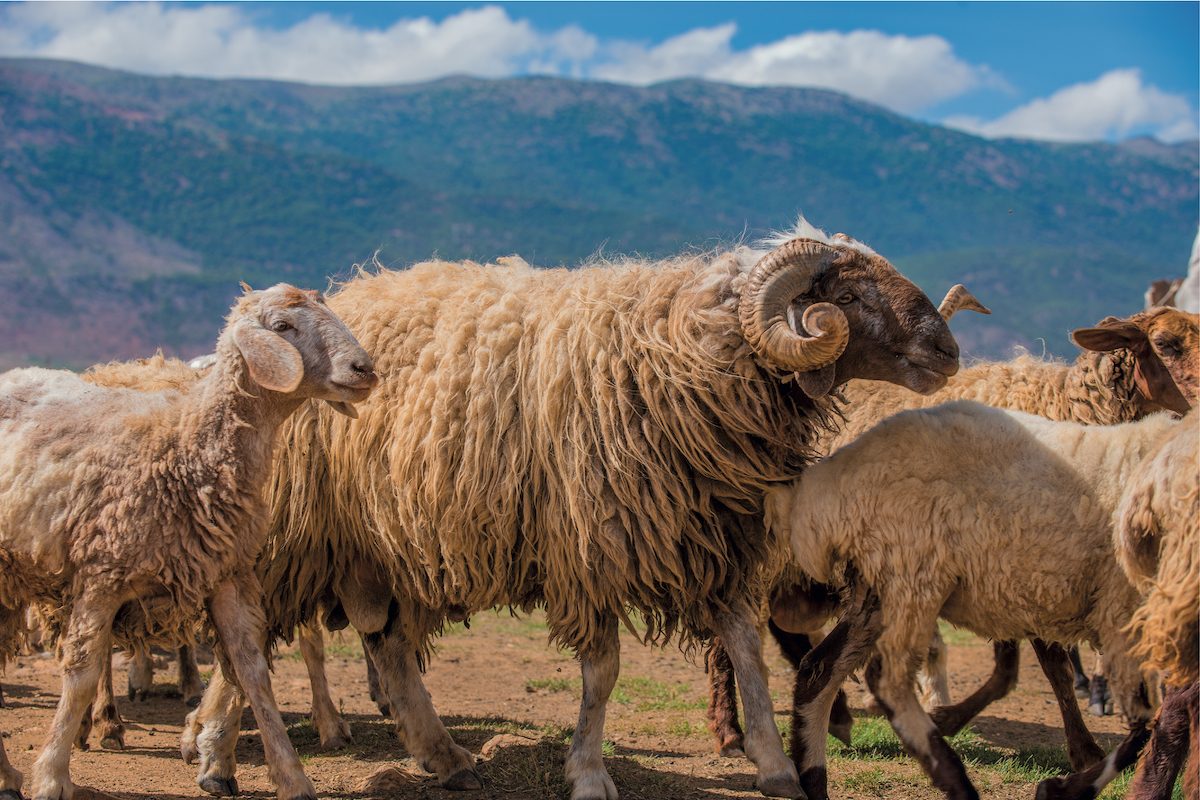Promoting Sustainable Land-use Practices
We aim to support the conservation of Lebanese cultural landscapes, their biodiversity and the ecosystem services they provide to people.

The main traditional practices represented by the project are:
Grazing, by which high mountain pastures are traditionally used for seasonal grazing during summer. Transhumance has a strong effect on species and community diversity, and vegetation dynamics creating openings and corridors in forest.
Dry stonewall terraces cultivation of olives, vineyards and a variety of fruit trees(Cherry, Apple, Almond,Orange, Lemon), which is a very ancient tradition with more than 5,000 years of history in Mount Lebanon and other areas in the country
Harvesting of wild medicinal/edible plants, by which hundreds of mountain flora have been traditionally used in medicine, cosmetics and cooking, many of which are still harvested by the local communities – mainly women.
The West Bekaa district spans across 470 km2, stretching from the highlands of the Shouf Mountain at an altitude of 1900 m in the west all the way down to the Bekaa plain, and then up again to the highlands of the Anti-Lebanon mountain range. The Himas of West Bekaa, namely Kherbet Kanafar, Ain Zebdeh, and Aitanit are located at the eastern slopes of the Shouf Mountain, overlooking the Beqaa Valley. They are located under the main migration flyway for soaring & water birds, a bottleneck area situated in the middle of the Shouf Biosphere Cedar Reserve, Ammiq wetlands, and Qaraoun Lake, which are areas of high biodiversity values; all identified and approved as Important Bird Areas-IBAs; situated at the narrowest Lebanese territory between Mount Hermon & Mount Lebanon, which makes it one of the top priority sites for conservation because the area is a resting & breeding site for a large number of threatened and endangered birds (Imperial Eagle, lesser Spotted Eagle, Shrikes, Buntings, Syrian Woodpecker), mammals (wolves, Striped Hyenas, porcupines, squirrels, badgers, Lynx & wild cat, etc..), and flora (mainly oak and pine forests and medicinal and edible endemic plants).
Agricultural and livestock activities are a main source of income for West Bekaa communities, in addition to producing historical top quality wine and ecotourism and recreational activities.
In phase ll of the project (2020-2022), SPNL scaled up to include four additional Hima sites in Mount Lebanon, specifically Kayfoun, Kfarmatta, Hammana, and Ras El Matn. The two latter are situated in the upper reaches of Beirut River Valley, which was declared as an Important Bird Area (IBA) and Key Biodiversity Area (KBA) in 2009 (BirdLife International). It is a deep river valley carved by the Beirut river, extending 20 Km eastwards from the outskirts of Beirut on the western slopes of the Mount Lebanon range. The IPA/KBA Beirut River Valley consists of valleys and large watersheds with many habitat types, such as lower, middle, and montane forests of evergreen oak, mixed pine-oak, and conifers, seasonal streams and perennial rivers, riparian galleries, stony cliffs, and small caves. With respect to flora, the valley supports a huge diversity of plants, particularly woodland species. This IPA includes around 550 wild plant species, including nearly 100 endemic species, 6 of which are endemic to Lebanon. Higher Metn region constitutes the upper boundary of the IBA/KBA Beirut River Valley. It is the most important bottleneck for migratory soaring birds during autumn migration season, stretching across several municipalities, with no fully-covered formal protection. Crafted in the Mount Lebanon valley, Hammana is one of the most well-preserved villages across the country. With its pine-covered valley, known as “Vallee de Lamartine”, named after the French poet Lamartine, Hammana has kept its architectural cachet with orchards, red-tiled stone houses, old market, traditional fountain, and old palaces, dating back to over 700 years ago. Historically, it was the economic hub of the Higher Metn district. Known for its panoramic sceneries and waterfalls, Hammana hosts around tens of springs, and ancient water canals supplying water from the famous Chaghour River to irrigate the agricultural lands. The village is known for its apple, bean, and cherry produce. Remarkably, the 50-year old cherry festival attracts hundreds of visitors from all over Lebanon and sells tons of cherries. Ras Al Metn, an extension of Beirut River valley IBA/KBA, is also rich in biodiversity and natural assets. It is an important source of pine production, where the latter accounts for two thirds of the output in the Higher Metn region and one-third of Lebanon's production. The village is also known for the cultivation of olives, grapes, figs, apricots and other fruits. Ras el Metn further possesses historic ruins including a large Serail, or government house, built by the Lamaayeen princes in 1775, Ein el Marj spring, built in 1472, the ancient tomb “Sitt Sarah”, in addition to a bridge and an Ottoman road dating back to 600 years ago. Additionally, Ras el Metn is a touristic destination offering activities like hiking along the Grotto of Hiskan and pine forests in addition to engaging with the community’s cultural practices and heritage.

Nowadays, the cultural landscape and its associated traditional practices are impacted by various threats: (i) Forest loss, degradation and fragmentation due to intense logging, wood and fodder collection, (ii) Overgrazing; (iii) Uncontrolled harvesting of non-wood forest and pasture products; (iv) Agricultural intensification; (v) Environmental threats, which are exacerbated by climate change: land degradation caused by rural abandonment, forest fires caused by the burning of agriculture waste and the accumulation of dry biomass on abandoned land; (vi) Lack of economic incentives to reverse rural abandonment and unemployment, which mostly impact women and youth.
The sustainable management of the cultural practices supported by the project ensures direct benefit to significant species and associated habitats at the area, and helps maintain healthy and biologically diverse agro-silvo-pastoral systems (e.g. transhumance grazing has a strong effect on species and community diversity, and vegetation dynamics creating openings and corridors in forest; the traditional harvesting of non-timber products from forests and pastures has led to a more or less intense domestication of plant species resulting in higher levels of genetic diversity that display greater resilience; the traditional cultivation in terraces allowed the selection of a highly diversified number of local crop varieties, and their dry stonewalls played an important role in terms of biodiversity conservation, as micro-habitats for rocky plants, insects, reptiles, amphibian, birds and mammals). Well maintained cultural practices also play an instrumental role in environmental risk reduction (e.g. stonewall terrace systems facilitate soil water infiltration and storage, and act as firebreaks reducing the risk of fire spread; transhumant grazing systems, create natural firebreak areas, regulate water runoff, and are home of beneficial insects that increase biological control of crop insect pests, and provide pollination services).
The project is driven by a multi-purpose, holistic approach and shaped along 8 strategies that are well-aligned with M6 OAP strategies:
Strategy 1: Partnership: Contributes to building a durable regional partnership for Cultural Landscapes beyond 2022.
Strategy 2: Knowledge: Generates knowledge to understand the link between CPs, biodiversity and human/socioeconomic wellbeing through developing an ecosystem services assessment and economic valuation of the identified ecosystem services in pilot sites, where all provisioning, supporting, regulatory and cultural services will be assessed.
The economic valuation is intended to enhance ecosystem-based resource management to lead to more resilient ecosystems, more effective conservation of biodiversity, and to contribute to climate change adaptation and mitigation, as well as to securing and strengthening local livelihoods and food security.
Strategy 3: Communications & Promotion: Focuses on effective communication to showcase the project outcomes and impact on the national, regional, and international levels.
Strategy 4: Economics & Finance: Supports economic diversification and livelihoods of the local communities by promoting alternative job opportunities, addressing capacities, and promoting high-quality traditional products associated with the different cultural practices, with focus on branding and marketing under Souk Al Hima programme. This will be strengthened through the two newly established conservation and community development centers in West Bekaa and Mount Lebanon; that will help in generating income through the commercialization of the products in their gift shops, eco-tourism and educational activities.
Strategy 5: Policy: Builds on lessons learned and best practices to advocate for policies in support of the cultural practices and land/resources management on the local/national level.
Strategy 6: Governance: Focuses on the Hima communal governance system for the management of land and natural resources and adapting the traditional concept of Hima to the actual context in pilot areas of the Western Beqaa and Mount Lebanon, addressing gaps and capacities.
Strategy 7: Local Capacity & Management: Addresses the capacities and knowledge needed to optimise practical conditions for the management and restoration of the landscape and its associated cultural practices; including sustainable management practices, mountain pastures restoration, dry-stone wall agricultural terraces restoration in pilot areas, and sustainable harvesting of wild plants.
Strategy 8: Scaling Up: Focuses on expanding and scaling up the application of sustainable cultural and management practices in the wider landscape and in new Hima sites in Mount Lebanon along with the dissemination of knowledge, awareness, capacity building, and education for the wider Lebanese community. Thus, contributing to replication in other Mediterranean cultural landscapes through sharing of know-how, best practices, and lessons learned among eco-cultural landscapes of high ecological value.
